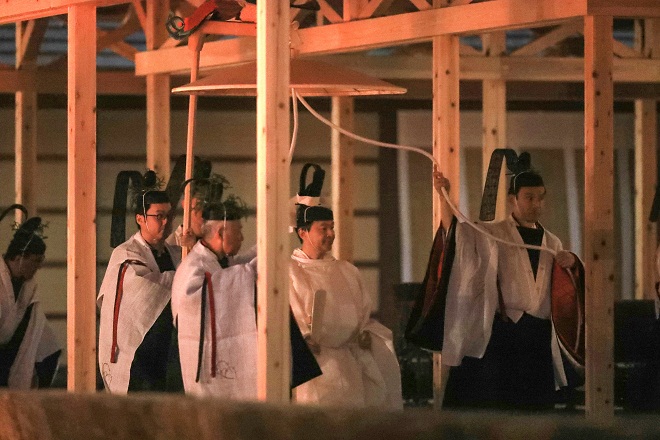FOCUS: State funding for Daijosai rite draws criticism from experts
November 15, 2019
Tokyo--The Japanese government's decision to finance the latest "Daijosai" key Imperial ceremony with state funds, as it did for the previous such event, has faced criticism from experts claiming the move was taken with undue speed in order to avoid reigniting controversy over the Constitution, which guarantees the separation of state and religion.
The key grand thanksgiving ceremony was conducted by Emperor Naruhito, who took the throne in May after the abdication of his father, current Emperor Emeritus Akihito, in April, from Thursday evening to the small hours of Friday.
In the centuries-old ceremony, the Emperor offers newly harvested grains to the deities to pray for good crops and peace in the country.
The Daijosai is an event held only once after the enthronement of an Emperor. It is "an extremely important once-in-a-lifetime ceremony related to Imperial succession," an Imperial Household Agency official said.
As with the previous Daijosai, conducted by then Emperor Akihito in 1990, the government covered the related costs of the latest ceremony with state funds, while characterizing the Daijosai as an Imperial Family event, unlike other enthronement-related ceremonies stipulated as acts of the Emperor in matters of state under the Constitution, due to the rite's strong religious nature.
The "Daijokyu," a set of halls where several rituals are conducted, is customarily dismantled after the ceremony.
The Imperial Household Agency reduced the scale of the latest Daijokyu by 20 pct from that of the previous one and made cost-cutting efforts, such as shifting to shingle roofs from thatched roofs and using prefabricated construction for some structures.
Despite these efforts, the costs related to the ceremony this year, including "Daikyo-no-Gi" grand banquets for the Emperor and guests to the Daijosai, to be held on Saturday and Monday at the Imperial Palace, totaled some 2,443 million yen, up by 200 million yen.
Prince Akishino's Call for Review
In November last year, at a news conference to mark his 53rd birthday, then Prince Akishino argued against the use of state funds for the Daijosai, which he described as highly religious. Related costs should be covered by funds set aside for personal expenses by the Imperial Family members, he said.
The prince added that originally the Daijosai was a ritual carried out in an "affordable" way.
The remarks by the current Crown Prince, the younger brother of Emperor Naruhito, sparked controversy as the government had already decided to cover the ceremony-related costs with state funds.
A government committee to prepare for the ceremony was set up in January last year. The following month, the committee decided to adopt the same stance taken at the time of the previous Daijosai in regard to costs and other aspects.
Although there were more than one and a half years left until the ceremony in 2019, minutes of committee meetings show no sign that adequate discussions took place. In addition, the state funding plan was not reconsidered even after Prince Akishino's remarks.
Lack of Enough Discussions
Citing the government's policy on Daijosai funding, Koichi Yokota, an honorary professor at Kyushu University, well versed in relations between the Constitution and the Emperor system, said, "If it is considered a religious rite, the ceremony should be funded with costs set aside for the Imperial Family, in line with the constitutional principle of the separation of government and religion."
In regard to then Prince Akishino's comments on costs, Yokota said: "It is reasonable. The Daijosai is traditionally more of a simple ceremony than something a lot of money is poured into."
Yokota criticized the government for neglecting to answer the question of government funding for Imperial succession rituals in light of the constitutional separation of state and religion.
"The government decided at an early stage to hold the ceremony in the same way as it did last time," he said.
Noting that there was enough time for preparation after the abdication of former Emperor Akihito was decided, Yokota said, "The government should have examined how related rituals should be handled in light of the Constitution."
Following the previous Daijosai, which was the first held under the postwar Constitution, a series of lawsuits was filed against the public funding for the ceremony. At the time, the Supreme Court clearly recognized the religious nature of the Daijosai.
Calling attention to the top court's ruling, Sota Kimura, a professor at Tokyo Metropolitan University, said, "Discussions should have been made more carefully than the previous time so as to avoid suspicions concerning the constitutionality of state funding for the rite."
"It is hard to say that sufficient discussions took place," Kimura said.
Meanwhile, Isao Tokoro, an honorary professor at Kyoto Sangyo University, argued that "the problems were cleared when discussions were made thoroughly 29 years ago."
On ceremony-related costs, Tokoro pointed to the difficulty of simply scaling back the ceremony considering the nature of the ceremony and its 1,300 years of history.
"Reconstructing structures is an integral part (of the Daijosai)," Tokoro said. Jiji Press
Latest Videos
- THE UNTOLD STORY EXPERT INSIGHTS INTO THE UKRAINE
- NEGOTIATING A NEW ORDER US RUSSIA TALKS ON UKRAIN
- Ukraine: A Pawn in the Geopolitical Game? Will Trump Intervene?
- US VP VANCE CRITICIZES EUROPEAN DEMOCRACIES AT MUNICH SECURITY CONFERENCE
- UNCOVERING THE WEB OF DECEIT: CIA INFILTRATION OF THE MEDIA
- SHIFTING SANDS: TULSI GABBARD’S CONFIRMATION AND THE EVOLVING GLOBAL LANDSCAPE
- FAUCI SCANDAL: A THREAT TO GLOBAL HEALTH AND DEMOCRACY






